Contents
What is back pain?
Lower back pain is probably familiar to almost every modern person. Employability can be affected by a wide variety of reasons. Among them are backache, sciatica, osteochondrosis and other pathological changes in the lumbosacral spine. You should not be inattentive to this, because back pain can not only reach incredible strength, making a person’s life unbearable, but also turn out to be a symptom of the most dangerous diseases.
Lower back pain can be varied: acute or dull, aching or burning, local (appear in one place) or spreading to the entire back. Unpleasant sensations also manifest themselves in different ways: sometimes abruptly, suddenly, and sometimes gradually, intensifying every day.
The reaction to pain and the ability to endure it depend on many factors: age, mental characteristics, accompanying symptoms, and others. But in any case, you can not leave the disease to chance. Timely treatment will help to avoid dangerous consequences.
To diagnose the cause of back pain, it is necessary to examine the spine and some additional procedures: X-ray examination, computed or magnetic resonance imaging.
Attacks of pain in the lumbosacral region occur during the life of approximately 80% of modern residents of European countries. Acute or chronic low back pain is a consequence of various neurological, degenerative-dystrophic diseases in women and men. In some cases, back pain is a consequence of diseases of the internal organs, obesity, stress and mental disorders.
Causes of back pain
The problem of chronic low back pain is rampant. The average age of the diseased is rapidly decreasing, currently it is 35-45 years. Even cases of illness of children and teenagers are registered.
A prerequisite for the development of pain in the lower back is a sedentary lifestyle of a modern person, leading to a decrease in the stability of the lower back, the most vulnerable part of the skeleton. Low back pain accompanies many diseases, they have become a common reason for visiting a neurologist, urologist, surgeon, gastroenterologist and gynecologist. The problem is expected to worsen further. The next generation does not have a healthy lifestyle.
Lower back pain in women
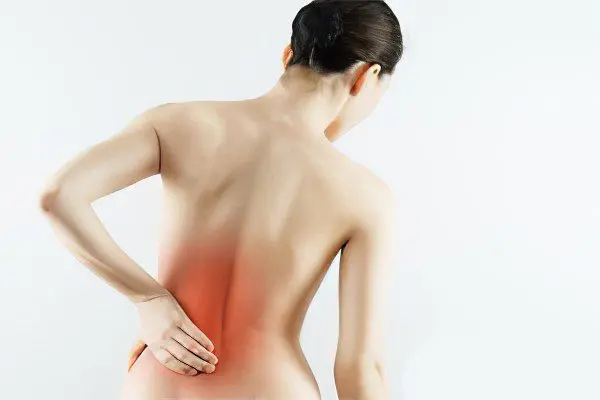
Occur during the period of gynecological diseases or are a consequence of the characteristics of female physiology:
Gynecological diseases. Inflammation of the appendages – adnexitis, accompanied by pain in the lower abdomen, sometimes the pain radiates to the lower back (pain is one- and two-sided), it is also manifested by symptoms from the intimate sphere (the inability to get pregnant, long-term spotting before and after menstruation, the pain intensifies during intercourse);
Pregnancy. The usual localization of pain in the groin, in the lower back is reflected for the following reasons:
increased load on the spine from the growing fetus, usually develops by the fifth month of pregnancy, discomfort disappears after childbirth;
the threat of premature birth, contractions that give off with pain in the lower back before 22-37 weeks of pregnancy (the norm is 40 weeks), are accompanied by unusual discharge, are considered dangerous: bloody – a sign of placental abruption, liquid and transparent – a sign of placental rupture.
Climax. The usual localization of pain in the head, chest, pain can change localization, including under the influence of:
unstable levels of estrogen in the blood, as a result, a violation of the blood circulation of the pelvic organs develops;
the initial stages of osteochondrosis, osteoporosis, hernias, and other superficial processes of the lumbar skeleton of the spinal column, similar to cases with the development of degenerative-dystrophic processes (See also: menopause in women, hot flashes, medicinal herbs).
Pain – a consequence of increased suspiciousness, more common in women. An in-depth, comprehensive examination does not reveal pathology. The problem may occur intermittently or continuously. It is treated with psychological correction. Such pains can occur outside the influence of menopause.
Lower back pain in men
Periodic pain occurs due to the peculiarities of the professional activity of men, including if the pain:
do not correspond to the physiological status of the body of a man;
associated with professional risks (work in the cold, draft).
Also, periodic pain in male diseases is detected as an exception for:
prostatitis – pain in the anus is characteristic, pain in the lower back is rare, against the background of general intoxication of the body, it is combined with pain in other parts of the bone tissue, hyperthermia, weakness, weakness, headache.
epididymitis – inflammation of the epididymis, manifested by pain in the groin, sometimes radiates (radiates) to the lumbar region, the disease is also characterized by swelling of the scrotum and fever.
Lower back pain in both men and women
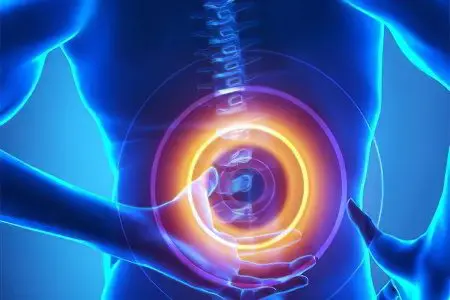
They arise in connection with acute diseases of the gastrointestinal tract, surgical complications, kidney diseases, metabolic disorders, diseases of an infectious nature and neoplasms (benign, malignant).
Appendicitis. The characteristic pain is localized in the right iliac region, sometimes it can radiate to the lower back, more often to the right side of the body. There is an indefinite pain in the lumbar region.
Pathology of the small intestine. Accompanied by symptoms characteristic of a disorder of the gastrointestinal tract. The pain radiates to the lower back due to irritation of the fibers of the lumbar nerves.
Cholecystitis. The pain is similar to the symptoms of appendicitis. Usually localized on the right side in the iliac region or in the navel. Sometimes they are given to the lower back when the fibers of the spinal nerves are involved in the pathogenesis.
Pancreatitis. Characterized by girdle pain around the body, in the waist, reflecting the lumbar. It is combined with symptoms characteristic of pancreatitis – vomiting, impaired defecation, plaque on the tongue. If the cause of the pain is pancreatitis, the region of the spinal column does not respond to the application of force when palpated.
Spikes after surgery. Occur after laparotomy or abdominal operations on the abdominal organs, sometimes congenital adhesions are diagnosed. The pain is localized in different parts of the abdominal wall, radiating to the lower back.
Kidney diseases. Lower back pain is combined with uremic symptoms, headache, increased diastolic (lower) blood pressure threshold, and edema. Characteristic changes are found in laboratory studies of urine, instrumental studies of the kidneys – ultrasound, MRI;
Obesity of the fourth degree. This is the extreme degree of fat mass increase in humans. The body mass index of the fourth degree (up to 25 years) = 40, the second group (after 25) = 41. It is defined as the ratio of mass (kg) to twice the height (m). The reasons for the load on the lower back are clear without explanation.
Инфекции with involvement in the pathogenesis of bone tissue, for example, extrapulmonary (bone) tuberculosis. Manifested by pain in the bones. The localization of pain in the lower back is due to the fact that this is the most massive section of the spinal column, and it is subject to maximum loads. Symptoms are associated with the clinic of chronic infection. Slight hyperthermia, fatigue, headache, symptoms of damage to the nervous system are detected, tuberculosis bacillus is detected in the laboratory.
Myositis is inflammation of the muscles. The muscles of the lumbar zone carry a large load, so inflammation of the lumbar zone is common. The disease develops as a result of hypothermia, the penetration of viral pathogens (herpes zoster), bacterial infections (staphylococci, streptococci, other pyogenic bacteria) into the tissues of this zone. It is manifested by an increase in body temperature, severe pain that develops suddenly, after local or general hypothermia. The chronic stage of the disease is manifested by aching pains, sometimes involving skin tissues and subcutaneous tissue (dermatomyositis). Diagnosis is carried out on the basis of a clinical survey of the patient, examination, palpation and laboratory methods.
Growth of benign and malignant tumors along the nerve fibers that innervate the lower back. The symptoms are varied, correspond to the stage of the disease and the localization of the pathology.
Persistent and intermittent lower back pain
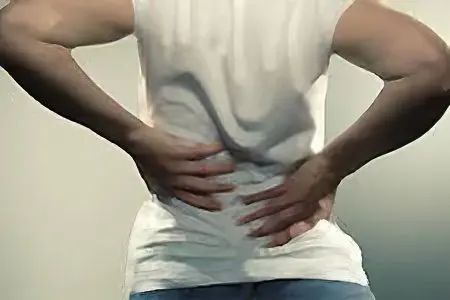
There are various classifications of pain, including depending on the duration.
Periodic pain is usually associated with physical exertion, the physiological characteristics of the human body or acute diseases of the internal organs.
Constant, acute, chronic pain caused by irreversible pathological processes in the body in diseases of the musculoskeletal system of the human skeleton and lesions of the deep vessels of the legs.
Intermittent back pain – so they are called because they disappear after recovery and elimination of the source of pain.
Low back pain that comes from the internal organs is usually:
reflected;
irradiating.
The origin of such pains may differ in women or men, or equally apply to men and women.
Persistent lower back pain are usually caused by inflammatory and irreversible dystrophic and degenerative processes in bone and cartilage tissue, severe disorders of blood flow in the vessels of the legs. Persistent pain is less associated with damage to the muscles and internal organs.
Pain is called constant when the elimination of the focus of the impulse is difficult due to the development of irreversible processes in the bone and cartilage tissue. Degenerative and dystrophic processes usually cannot be completely cured. They can be suspended or stopped for a while. In some cases, pain is eliminated after the replacement of damaged tissues with an implant.
The occurrence of pain in the lumbar region is associated with irritation:
nerve fibers emerging from damaged lumbar vertebrae.
nerve nodes near the spinal column of the lumbar and sacral.
Unlike temporary pain, the source of permanent pain is located directly in the lumbar region. In this regard, it is appropriate to give brief information about the spine.
The human spinal column consists of five sections and 32-34 vertebrae, including:
cervical – 7 (lat. Ceruicis);
chest – 12 (lat. Thoracis);
lumbar – 5 (lat. Lumborum);
sacral – 5 (lat. Sacralis);
coccygeal – 3-5 (lat. Сoccyx).
If the letters C, Th, L, S and Co are found in the medical literature describing neurological and bone pathology, then they denote the first letters of the Latin equivalent of the Russian names of the spine.
There are five vertebrae and pairs of nerves in the lumbar region, which are designated L1-L5.
The localization of pain during stimulation of different pairs of nerves was established experimentally.
Localization of pain, depending on the defeat of the lumbar vertebrae:
first or second, pain in the thigh and in front of the knee;
third or fourth, pain in the knee and upper leg;
fourth or fifth, pain in the legs up to the first toe from the outside;
fifth lumbar and first sacral, pain in the legs up to the fifth toe behind.
Periodic and persistent pain often have a close relationship with each other, so temporary pain becomes permanent.
For example, bone tuberculosis causes malnutrition of cartilage tissue, provokes osteochondrosis, and pain manifests itself almost constantly with periods of weakening and exacerbation.
Curvature of the spine (scoliosis) at first goes unnoticed, appears periodically, then turns into osteochondrosis and is manifested by constant pain. The examples go on.
Diseases accompanied by constant back pain:
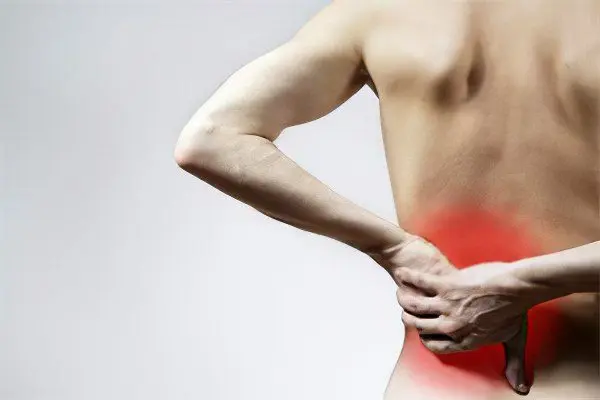
Lumbago – Sharp back pain. The consequence of pathological changes in the lumbar vertebrae. In the initial stages, pain can be stopped, since the pathological process is eliminated with timely treatment. It develops suddenly, when lifting weights and other similar reasons. More often diagnosed in men. Lumbago is a possible consequence of several diseases, for example, displacement, herniated disc, pinched nerve roots in the lumbar region (neuralgia), inflammation or pinching of the sciatic nerve – sciatica, osteochondrosis, and other anomalies of the vertebrae. In addition to severe acute pain, it is manifested by a decrease in skeletal mobility in the lumbar region. With ischalgia, the pain shifts lower to the buttocks and back of the legs. In the absence of therapy or improper treatment, lumbago can develop into an irreversible bone disease.
Intervertebral osteochondrosis – includes several diseases of an inflammatory and dystrophic nature, manifested initially by loosening of the articular surface of cartilage and bone tissue with involvement of nerves in the pathogenesis. The consequences of osteochondrosis are:
sciatica – inflammation, compression of the sciatic nerve, manifested by pain in the lower back and in the back of the legs;
sciatica of the lower back – inflammation of the roots of nerve fibers, manifested by pain, impaired sensitivity, complete or partial loss of motor activity;
protrusion of the intervertebral disc, one of the stages of osteochondrosis, is manifested by protrusion of the intervertebral cartilage without violating its integrity, this stage is followed by a hernia of the spine;
lumbar hernia – protrusion, violation of the integrity of the cartilage and intervertebral membranes, compression of the nerve roots, loss of joint function.
Scoliosis. Lateral curvature of the vertebrae, manifested by the asymmetry of the shoulder line, disturbed posture, deformation of the skeleton, the formation of a costal hump, which is visible when bending. It develops with a decrease in the functions of the bones of the skeleton and muscles, dystrophic processes in the cartilaginous tissue of the lower back. Manifested by pain in the bones of the skeleton in complicated cases. For a long time, scoliosis is asymptomatic. Scoliosis can be congenital or acquired. Acquired scoliosis in the lumbar region:
habitual, develop in childhood, as a result of incorrect posture;
rachitic scoliosis, a consequence of metabolic disorders in childhood against the background of incorrect posture during various physical activities;
rheumatic, develop in adults, as a result of inflammatory-dystrophic processes of nerves, then muscle and bone tissue;
paralytic, develop more often in adults, there is a violation of the motor function of the muscles of the lumbar region.
Ankylosing spondylitis – Loss of joint mobility. Much more common in men. Another name for the pathology is Bechterew’s disease. It is chronic inflammation. The disease is manifested by pain in the joints and spine, characterized by eye damage, a decrease in human growth. In this case, the connective tissue of the joints of the spine grows. Pathogenesis is accompanied by enslavement and complete loss of mobility of the joints of the lower back and other parts of the skeleton.
Spondylosis. This is the natural aging process of the joints. There is a gradual thinning and loss of mobility of the lumbar joints. Pathogenesis unfolds with complications and the addition of inflammation to the course of spondylosis. Symptoms correspond to inflammation of the joints of the spine.
Rheumatoid arthritis, mostly women are ill. Systemic chronic inflammation of the joints with involvement in the pathogenesis of muscles, ligaments, cartilage of the spine, including the lower back, and other organs. The causes of the disease are autoimmune processes, often RA develops during menopause.
Osteoporosis – thinning, leaching of calcium from bone tissue. Often causes hip fractures. Lumbar osteoporosis is also observed. Manifested by deformation of the skeleton, joints, cartilage, the development of herniated vertebrae. Women are more likely to get sick during menopause.
leg length difference more than 2-3 cm, accompanied by a variety of pain when moving, including pain in the lower back. Pathology develops as atrophy of the muscles of one leg due to polio and other pathologies suffered in childhood. In some cases, the problem is dealt with with the help of an orthopedic tab. The defect is difficult to correct if there is too much difference in leg length or if the foot is flat.
Phlebothrombosis – partial or complete cessation of blood flow through the deep veins of the human leg. There is no inflammation. The disease is more often recorded in women who wear high-heeled shoes for a long time. Other causes are possible (strokes, heart attacks, forced long-term hemostasis). It develops with a combination of three factors: thickening of the blood, pathology of the walls of blood vessels, slowing down the flow of blood through the vessels. Lower back pain occurs during a long walk, with the development of pathogenesis, it can turn into constant pain.
Thrombophlebitis – partial or complete cessation of the blood flow of deep vessels. Associated with inflammation around the vessel. This complicates the course of the disease, provokes the development of pain even at rest.
Atherosclerosis of the third or fourth degree. This disease is typical for older men. It is associated with a slowing or stopping of blood flow due to narrowing of the lumen of the blood vessel by cholesterol plaques. The third-fourth stages of atherosclerosis are critical and are subject to surgical intervention.
Lower back pain – sick kidneys?
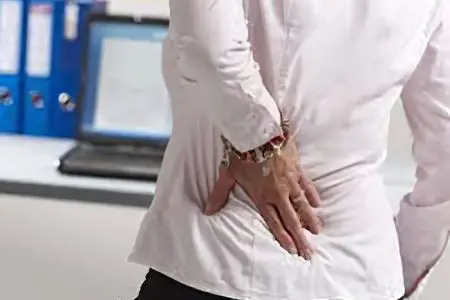
The kidneys are a paired organ that performs the function of forming and excreting urine, located in the abdominal cavity from the sides of the lumbar spine. Almost always, kidney disease is manifested by pain in the lower back. In many cases, the pathogenesis extends to only one kidney, which greatly simplifies the differentiation of pain. In addition, pain is combined with characteristic signs of a violation of the formation and / or excretion of urine, with the phenomena of general intoxication of the body. Difficulties in differential diagnosis may arise in the acute course of kidney pathology. A chronic course with a slow development of pathology usually accurately indicates the localization of the focus of pain.
Many researchers have noticed that various pathologies of the kidneys sometimes have a sexual predisposition. Some often develop in men, others in women, which is explained by the morphological and physiological features of the structure and functioning of the urinary organs in different sex groups.
Pain characteristics of the most common kidney pathologies:
pyelonephritis – inflammation of the renal pelvis and other morphological structures. More commonly diagnosed in females. The disease can proceed without violation of urination. The differential diagnosis is based on the fact that pain is usually one- or two-sided, combined with general intoxication of the body, which is extremely rare with pain associated with damage to the lumbar nerves. Symptoms of general intoxication: high fever, vomiting, weakness, chills.
Renal insufficiency – a pathological condition, the loss of the ability of the kidneys to form urine. The attack develops suddenly. Severe back pain is combined with a rapid deterioration of the clinical condition. The bladder is poorly filled or empty. Signs correspond to the severity of pathogenesis.
Descent of the kidney. Women get sick more often. Normally, the kidney, due to the mesenteric ligament, can be displaced by no more than 1 cm from the point of attachment to the skeleton. The causes of omission are injuries, sudden weight loss (for example, after pregnancy), weight lifting, as a result, the retaining ligament is lengthened. Differentiation is based on the occurrence of pain when the kidneys are displaced. A large degree of freedom of the organ is felt by severe pain when bending and turning the body, performing actions with lifting weights; associated with uremic symptoms and urinary incontinence.
Gout. Men are more often ill. Violation of the excretion of uric acid and its accumulation in the blood. Severe back pain is combined with signs of kidney damage. The disease develops gradually, so the doctors and the patient have time to determine the cause of the pain.
Nephropathy diabetic. Men are more often ill. A complex disease with damage to the vessels of the kidneys in the form of arteriosclerosis. Since this disease develops gradually and is associated with diabetes, the differential diagnosis is based on an in-depth examination of the person.
Renal colic – an attack of acute pain. Several causes of colic have been identified. The most likely cause is kidney stones. The pain is associated with the inability to empty the bladder. The first signs of pain are detected in the lower abdomen, the pain only radiates to the lower back. Other causes of pain are infections, cancer, kidney injury.
Hydronephrosis. It is more often diagnosed in young women. Hydronephrosis is a disease that results in the expansion of the cavities (pelvises) inside the kidneys. The pathogenesis of the disease is characterized by stages from mild to severe stages of impaired functioning of the organ. In severe cases, the function of urine formation stops. Differential diagnosis of low back pain is difficult only in the initial stages.
glomerulonephritis is an inflammation of the glomeruli (glomeruli). It is more often diagnosed in young men. The cause of the disease is sexual infections, colds, oncology. The glomeruli act as a biological filter. With development, the pathology is manifested by the release of cloudy or bloody urine. Differential diagnosis is difficult in the early stages of the disease.
Jade lupus It is predominantly a female disease. Systemic lupus is an autoimmune disease. Accordingly, lupus nephritis nephritis is an autoimmune lesion of the kidneys. In addition to the kidneys, damage to the internal organs of a person is diagnosed, including the heart, joints, ligaments, muscles. Damage to the joints of the lower back can make it difficult to diagnose pain in the initial stages of lupus nephritis.
Dysmetabolic nephropathy. It usually develops in childhood and worsens during adolescence. It is characterized by a violation of the excretion of end products of metabolism (not uric acid) from the body. As a result, urolithiasis develops with blockage of the urinary tract, or the formation of kidney stones. Differential diagnosis is based on laboratory tests and determination of the level in biological fluids (cystine, arginine, lysine, and other substances).
Renal stone disease. The disease is more common in men (they have a narrower urethra than women). The pain manifests itself when the stone moves in the cavities of the kidneys, it is almost always one-sided. In exceptional cases, there is pain in the lower back without a specific localization.
Amyloidosis of the kidneys. Violation of protein metabolism in the kidneys. Several types of amyloid are identified. Pathogenesis develops slowly, in the first stages compensatory mechanisms are activated, there are no symptoms of the disease. In the later stages, edema develops, pain in the lumbar region is a consequence of impaired excretion of urine from the body. Differential diagnosis is based on the use of laboratory research methods.
Lower back pain when bending over

The lumbar region is the center of gravity of the human body, so it is here that the main loads on the spine fall when bending over. The lower back is the support of the abdominal and pelvic organs, which are held together by the skeleton and muscles. This area contains important nerve nodes that provide innervation to the lower body.
Therefore, pain when bending over is a possible sign of damage:
muscles and ligaments of the lumbar zone;
bone and cartilage tissue of the spine;
internal organs of the abdominal cavity and small pelvis.
It is impossible to give a complete description of lower back pain when bending over, but let’s try to talk about the most likely scenarios for the development of pain syndrome.
Muscle damage
Pain with damage to the muscles and ligaments is the most common cause of acute pain in the lower back when bending over. Probable causes: local cooling of the lower back when dressing out of season, excessive physical exertion, unsuccessful bending during physical work and sports exercises, provoking inflammation, stretching of muscles and ligaments.
Pain is characterized by:
the appearance after monotonous monotonous (tilts) loads on the lower back;
suddenness, keeping it calm;
absence of inflammatory processes of internal organs and bone tissue.
Joint displacement
Acute lower back pain with displacement of the joints is a consequence of injuries of various etiologies during physical exertion.
Pain is characterized by:
the appearance after sharp, strong physical exertion on the lower back;
suddenness, often absence of pain when immobile;
its combination with the displacement of the vertebrae and inflammation of the adjacent muscles.
Inflammation of internal organs
Acute pain radiating to the lower back in diseases of the internal organs is the result of acute inflammation, such as: acute appendicitis (localization not characteristic in most cases of pathology), acute pancreatitis – inflammation of the pancreas, gynecology and others.
Characterized by:
obligatory course against the background of signs of damage to the organ that provokes pain;
optional localization in the lumbar region;
disappearance when the focus of pathology is eliminated with the help of surgery, antibiotics and other methods of treatment.
Low back pain symptoms
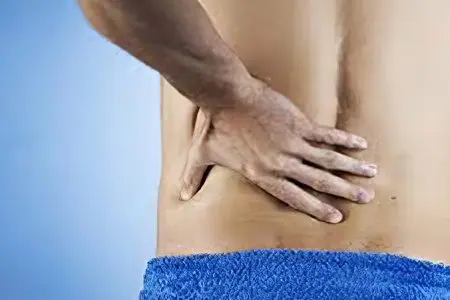
Primary information about pain can be used to characterize sensations at a neurologist’s appointment.
Low back pain is a lesion of peripheral nerves, which have both sensory and motor fibers. This means that the feeling of pain is almost always accompanied by a violation of the function that regulates movement. In practice, this means that pain and decreased mobility are links in the same chain.
Let’s take a look at the symptoms of low back pain. First of all, we will divide them into several types depending on the reasons.
With sprains, the pains are spasmodic, limiting the movement of the muscle group of the lumbar region, extending to the buttocks and back of the legs. It is difficult for a person to bend over and turn from side to side.
With damage to the nerve roots, pain from the lower back passes to the legs (one or both). Accompanying sensations are numbness, a feeling of “goosebumps”. When a person sneezes, coughs or takes a deep breath, stands or sits for a long time, the pain usually gets worse.
When a disease (sciatica, osteochondrosis) becomes the cause of back pain, the symptoms most often increase gradually, the pain intensifies over time and may not go away for a long time.
The strength of pain can be established by examining:
eye – the pupil is dilated;
hearts – rapid heartbeat;
skin – sweating;
body temperature – fever.
Low back pain can be:
local – its source is in the lumbar region;
irradiating – the pain impulse comes to the lower back along the branches of the nerves;
reflected – a pathological impulse is formed opposite the place of manifestation of pain.
The last two types of pain are interrelated. Reflected pain in the lower back is always combined with symptoms of damage to the organ from which the pain impulse comes to the lower back. For example, frequent urination with lower back pain is a sign of kidney or bladder disease.
According to the intensity of lower back pain, they are divided into: strong, weak, shooting, aching, permanent, temporary, encircling.
Remember: if the pain in the lower back lasts longer than three days, it is imperative to seek qualified medical help, because the longer you endure, the more cost and effort will need to be applied to the treatment.
Girdle pain in the lower back
It feels like squeezing the body around the waist with a tight, wide belt. Such pain is usually a sign of pancreatitis (inflammation of the pancreas), some variants of appendicitis, diseases of the internal organs with extensive damage to nerve fibers. Rarely, such pain is evidence of damage to the spine.
To determine the cause of lower back pain at home, pay attention to accompanying symptoms, for example: pain with pancreatitis is usually intense, with appendicitis it is different, often weak, pulling. Vomiting with appendicitis is often single, with pancreatitis multiple.
Stitching pain in the lower back
Sharp, stabbing pain in the lower back – lumbago. In addition to pinched nerve and herniated vertebrae, the pain impulse can come from the muscles of the lower back. This is the result of a point focus of inflammation of the nerve.
Frequent urination
The problem of young women. Exacerbation is possible with painful cycles. Another cause of frequent urination is cystitis. It manifests itself in gynecology as a result of reflex irritation of the bladder. The most likely localization is in the lower abdomen. Low back pain is referred pain. Usually passes after the appointment of a gynecologist. It is advisable to be examined by a neurologist and gynecologist.
Temperature for back pain
A sign of involvement of inflammation of the muscles, including in the lumbar region. With inflammation without the involvement of pathogenic microflora, the temperature is kept at 37,00C. If the pain is due to an infection, such as herpes zoster (girdle pain in the lower back), the temperature reaches 38,0-39,00C and is combined with other symptoms indicating an infection. With zoster infection, it is a rash on the skin. You should always be attentive to such a dangerous multifactorial symptom as hyperthermia.
What to do with severe back pain?
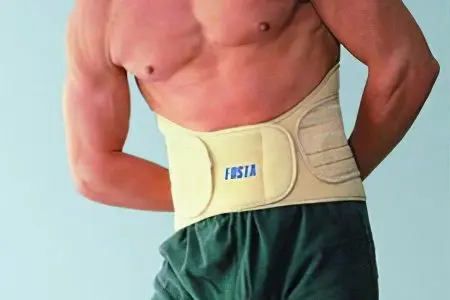
The optimal algorithm of actions in the event of an attack of lower back pain:
If the cause of the pain is unknown, measure the temperature, this indicator may suggest the presence of inflammation and infection; identify concomitant symptoms (vomiting, diarrhea, tongue coating, lower back pain on the one hand, the other); call a doctor and get tested.
If the cause is known (contusion, muscle strain), you should:
If the cause is known (displacement of the vertebrae), you should follow the recommendations of paragraph 2, then go to the clinic, undergo a diagnostic examination of CT, MRI, get recommendations for the reduction of the vertebrae by a chiropractor.
2.1. take one of the non-steroidal anti-inflammatory drugs (diclofenac, ibuprofen), this will relieve inflammation and reduce pain;
2.2. take a diuretic (veroshpiron) once, helps relieve swelling, enhances the circulation of fluids in the focus of inflammation, which contributes to the rapid evacuation of harmful substances from the body.
2.3. Pull the lumbar area with a towel or orthopedic belt, this will help fix the muscles and bones in a stable state.
2.4. See a doctor for advice, diagnosis and treatment.
What not to do with severe lower back pain:
Warming the affected area will exacerbate the process, as heat increases blood flow.
Relieve pain with unknown causes and protracted processes. This cannot be done, since pain relief can provoke further destruction of bone tissue and irritation of muscle fibers during movements in the absence of discomfort.
To adjust the vertebrae by a chiropractor without examining and establishing the causes of the displacement. Displacement of the vertebrae is not always the result of an injury; it can also occur as a result of dystrophic processes. Regular reduction can permanently destroy the processes of the vertebra and pinch the nerve.









